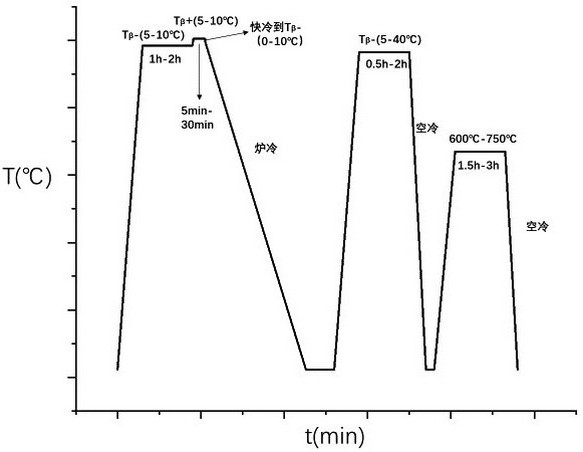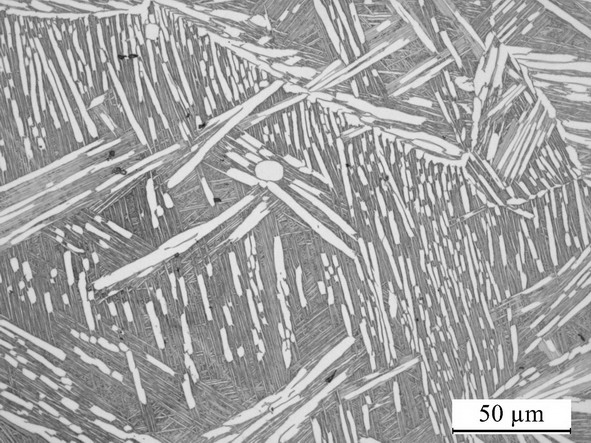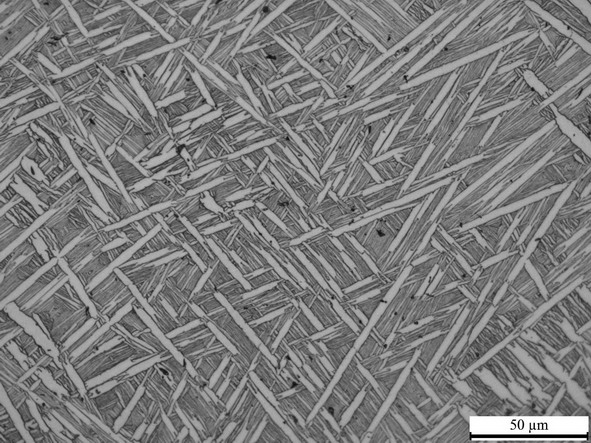A kind of heat treatment method to obtain high damage tolerance titanium alloy
A heat treatment method and damage tolerance technology, applied in the field of titanium alloys, can solve problems such as difficulty in meeting high damage tolerance, and achieve the effects of high temperature creep performance, large specific surface area, and high resistance to fatigue crack growth
- Summary
- Abstract
- Description
- Claims
- Application Information
AI Technical Summary
Problems solved by technology
Method used
Image
Examples
Embodiment 1
[0028] For the TA15 titanium alloy with dual-state structure after α+β forging, the phase transition point was measured by metallographic method to obtain a phase transition point of 995 °C, and then the same heat treatment furnace was applied, heated to 990 °C for 1 hour, and then heated Keep the temperature at 1005 °C for 20 minutes, take the sample out of the heat treatment furnace and cool it in air for 10 seconds, cool it to 985 °C, set the temperature of the heat treatment furnace to 985 °C, put the sample back into the heat treatment furnace, turn off the furnace and cool it to room temperature. After that, double-stage annealing heat treatment was carried out, heated to 960 °C for 1 hour, then air-cooled to room temperature, and then heated to 670 °C for 2 hours, and then air-cooled to room temperature to obtain a two-state structure with tentacle-like primary α phase and β transition structure. , the volume fraction of the tentacle-like primary α phase is 32-37%, and i...
Embodiment 2
[0030] For the TC4 titanium alloy with a mesh basket structure after laser additive manufacturing, the phase transition point is 1005°C after the phase transition point test by the metallographic method, and the α phase width is 2μm. The same heat treatment furnace is used to heat it to 1000°C Incubate for 1 hour, then turn off the stove and cool to room temperature. After that, double-stage annealing heat treatment was carried out, heated to 985 °C for 1 hour, then air-cooled to room temperature, then heated to 680 °C for 1.5 hours, and then air-cooled to room temperature to obtain a two-state structure with tentacle-like primary α phase and β transition structure. , the volume fraction of the tentacle-like primary α phase is 30-33%, and its microstructure is as follows image 3 shown. The obtained samples were tested for their plane fracture toughness, K IC Up to 124MPa*m 1 / 2 , impact toughness a KU Reached 42-46J / cm 2 . Damage tolerance performance is good.
Embodiment 3
[0032] For the forged TC4DT with coarsely deformed Widmandelstein microstructure, the width of the α phase is 7 μm, and the phase transition point is 1000 °C obtained by the metallographic method. The same heat treatment furnace is used, heated to 980 °C, and after holding for 1 hour, air-cooled to room temperature . Subsequently, it was heated to 650°C, kept for two hours, and then air-cooled to room temperature. A dual-state structure with a tentacle-like α phase and a β-transition structure was obtained, and the volume fraction of the tentacle-like α phase reached 38-40%. Its plane fracture toughness test, K IC Reached 130MPa*m 1 / 2 , the impact toughness reached 48J / cm 2 . Excellent damage performance.
PUM
| Property | Measurement | Unit |
|---|---|---|
| phase transition temperature | aaaaa | aaaaa |
| phase transition temperature | aaaaa | aaaaa |
Abstract
Description
Claims
Application Information
 Login to View More
Login to View More - R&D
- Intellectual Property
- Life Sciences
- Materials
- Tech Scout
- Unparalleled Data Quality
- Higher Quality Content
- 60% Fewer Hallucinations
Browse by: Latest US Patents, China's latest patents, Technical Efficacy Thesaurus, Application Domain, Technology Topic, Popular Technical Reports.
© 2025 PatSnap. All rights reserved.Legal|Privacy policy|Modern Slavery Act Transparency Statement|Sitemap|About US| Contact US: help@patsnap.com



